Beginner's Guide to Pens: Everything You Need to Know about Pens

Hey there, pen enthusiasts, doodlers, and note-takers!
Are you ready to embark on an exciting journey through the wonderful world of pens?
Whether you're an aspiring artist, a seasoned writer, or just someone who appreciates the art of handwriting, this beginner's pen guide is for you.
From classic ballpoints to sophisticated fountain pens, we'll explore the diverse range of pens available and discover their unique features, advantages, and best uses.
So, grab your favourite notebook and let's dive in!
Types of Pens
- Fountain pens
- Ballpoint pens
- Rollerball pens
- Multifunction pens
- Stylus pens
- Calligraphy pens
- Highlighter pens
- Paint marker pens
- Dry-wipe pens
- Textile marker pens
- Left handed pens
Fountain Pens
Let's start with the epitome of elegance and sophistication: the fountain pen.
These timeless writing instruments use liquid ink delivered through a nib, resulting in smooth, flowing lines.
The best fountain pens come in a variety of designs, from sleek modern styles to vintage-inspired classics.
Learn about the anatomy of a fountain pen.
Advantages of Fountain Pens
- Exceptional writing experience with smooth and consistent ink flow.
- Customizable nibs for different writing styles and line widths.
- Reusable and refillable, reducing waste and saving money in the long run.
Disadvantages of Fountain Pens
- Requires regular maintenance, such as cleaning and refilling ink cartridges.
- Can be prone to leaking if not handled properly.
- Initial investment may be higher compared to other types of pens.
Example: Lamy Safari Fountain Pen
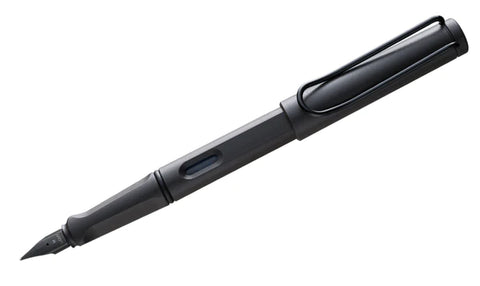
Uses: Journaling, letter writing, personal expression.
Check out the biggest fountain pen mistakes to avoid.
Ballpoint Pens
Next up, we have the ubiquitous ballpoint pen, a staple in offices, schools, and households worldwide.
The best ballpoint pens use a small rotating ball to dispense oil-based ink onto the paper, resulting in quick-drying and smear-resistant lines.
Advantages of Ballpoint Pens
- Reliable and long-lasting, with ink that dries quickly to prevent smudging.
- Available in a wide range of colours and designs.
- Affordable and widely accessible.
Disadvantages of Ballpoint Pens
- Limited ink colour options compared to other types of pens.
- Tendency to skip or produce uneven lines, especially with lower-quality pens.
- Not as smooth or comfortable to write with as fountain pens or rollerball pens.
Example: Caran D'ache 888 Infinite Ballpoint Pen

Uses: Note-taking, jotting down quick memos, filling out forms.
Rollerball Pens
Combining the smoothness of fountain pens with the convenience of ballpoint pens, rollerball pens offer the best of both worlds.
The best rollerball pens use liquid ink like fountain pens but with a ballpoint mechanism for easy use.
Advantages of Rollerball Pens
- Smooth and effortless writing experience, with vibrant ink colours.
- Quick-drying ink that minimizes smudging.
- Available in a variety of tip sizes for different writing styles.
Disadvantages of Rollerball Pens
- Ink may bleed through thinner paper, especially with darker colours.
- Limited ink capacity compared to fountain pens.
- Prone to drying out if left uncapped for extended periods.
Example: Pentel Energel Sterling Gel Rollerball Pen
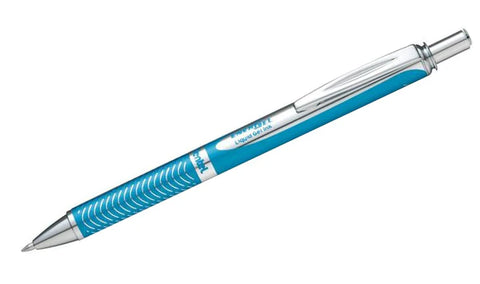
Uses: Creative writing, sketching, brainstorming.
Multifunction Pens
If versatility is what you're after, look no further than multifunction pens.
These ingenious writing instruments feature multiple refillable cartridges, allowing you to switch between different ink colours or writing styles with ease.
Advantages of Multifunction Pens
- Convenient and space-saving, with multiple ink colours or writing tools in one pen.
- Ideal for color-coding notes or highlighting important information.
- Some models feature additional features like a stylus tip or mechanical pencil.
Disadvantages of Multifunction Pens
- Bulkier and heavier than single-function pens.
- May require more frequent refills, leading to higher ongoing costs.
- Limited ink colour options compared to single-function pens.
Example: Lamy St Tri Pen
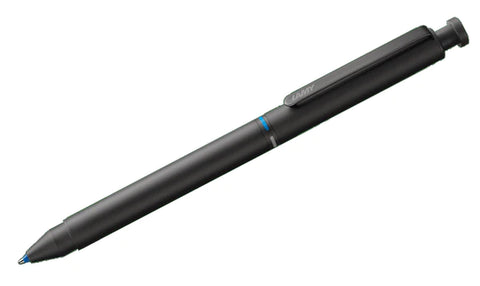
Uses: Color-coding notes, marking up documents, sketching on-the-go.
Stylus Pens
In the digital age, stylus pens have become indispensable tools for navigating touchscreen devices like smartphones and tablets.
These pens feature a soft, rubber tip that mimics the touch of a finger, allowing for precise control and accuracy.
Advantages of Stylus Pens
- Allows for precise navigation and drawing on touchscreen devices.
- Prevents fingerprints and smudges on screens.
- Some models feature a dual design with a traditional pen on one end and a stylus on the other.
Disadvantages of Stylus Pens
- Limited to use on touchscreen devices, with no functionality on paper.
- Tip may wear down over time, reducing accuracy.
- Not suitable for all types of digital art or writing.
Example: Lamy Al-Star EMR Digital Pen
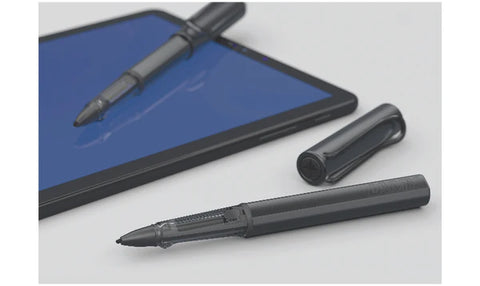
Uses: Digital drawing, note-taking on tablets, playing touchscreen games.
Calligraphy Pens
For those who want to elevate their writing to an art form, calligraphy pens are a must-have.
The best calligraphy pens feature a unique nib design that allows for varying line widths depending on the pressure applied.
Advantages of Calligraphy Pens
- Perfect for creating decorative lettering and embellishments.
- Allows for artistic expression and creativity.
- Available in a variety of nib sizes and styles for different calligraphy styles.
Disadvantages of Calligraphy Pens
- Steeper learning curve compared to traditional pens.
- Requires practice to achieve desired results.
- Some models may be more prone to ink flow issues or splattering.
Example: Pilot Parallel Pen
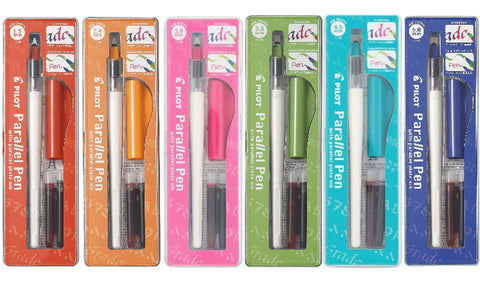
Uses: Hand-lettering, wedding invitations, creating artwork.
Take a look at our beginner's guide to calligraphy pens for more information.
Highlighter Pens
When it comes to marking important passages in textbooks or documents, highlighter pens are indispensable tools.
These brightly coloured markers feature a chisel or bullet tip for precise highlighting, making it easy to draw attention to key information.
Advantages of Highlighter Pens
- Bright, vibrant colours that stand out on the page.
- Quick-drying ink that prevents smudging or bleeding through paper.
- Available in a variety of colours for color-coding and organizing information.
Disadvantages of Highlighter Pens
- Can sometimes be too bold or overpowering, making text difficult to read.
- Not suitable for use on thin or delicate paper.
- Ink may fade over time, especially with exposure to light or heat.
Example: Stabilo Boss Highlighters
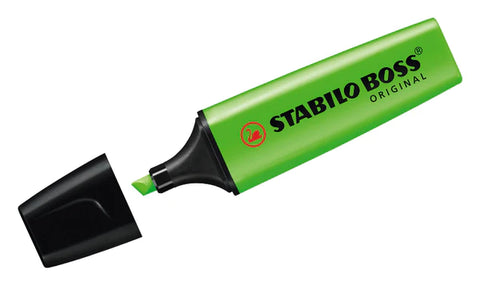
Uses: Studying, annotating documents, organising notes.
Did you know Stabilo highlighters come in a variety of colours?
Paint Marker Pens
For projects that require bold, opaque lines on a variety of surfaces, paint marker pens are the perfect choice.
These pens use pigmented, oil-based ink that adheres to almost any surface, including paper, plastic, metal, and glass.
Advantages of Paint Marker Pens
- Provides excellent coverage and visibility on dark or non-porous surfaces.
- Waterproof and fade-resistant ink for long-lasting results.
- Ideal for outdoor or industrial applications.
Disadvantages of Paint Marker Pens
- Requires shaking or priming before use to ensure proper ink flow.
- May have a strong odour due to the volatile solvents used in the ink.
- Limited colour options compared to other types of pens.
Example: Posca Paint Marker Pen

Uses: Crafting, DIY projects, graffiti art.
Dry-Wipe Pens
Commonly used on whiteboards and other non-porous surfaces, dry-wipe pens offer easy erasability and vibrant colours.
These pens use a specially formulated ink that can be wiped away with a dry cloth or eraser, making them perfect for brainstorming sessions, presentations, and classroom activities.
Advantages of Dry-Wipe Pens
- Allows for quick and easy writing, drawing, and erasing on whiteboards.
- Available in a variety of colours for color-coding and visual presentations.
- Ink dries quickly to prevent smudging or ghosting on the board.
Disadvantages of Dry-Wipe Pens
- Limited to use on whiteboards or other non-porous surfaces.
- Ink may fade or become less vibrant over time, especially with frequent use.
- Some models may be prone to drying out if left uncapped.
Example: Staedtler Lumocolor Whiteboard Marker
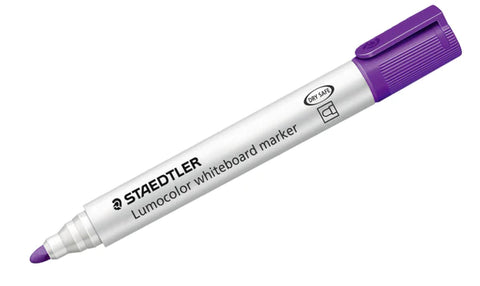
Uses: Whiteboard presentations, brainstorming sessions, teaching.
Textile Marker Pens
Finally, we have textile marker pens, which are specifically designed for writing and drawing on fabric.
Whether you're personalising a T-shirt, adding embellishments to a tote bag, or labelling clothing items, textile marker pens offer permanent, fade-resistant ink that withstands washing and wear.
Advantages of Textile Marker Pens
- Provides permanent, wash-resistant ink for fabric customization.
- Available in a variety of colours and tip sizes for different fabric types and projects.
- Ideal for DIY clothing customization and textile art projects.
Disadvantages of Textile Marker Pens
- Ink may bleed or spread on certain fabric types, requiring practice and experimentation.
- Limited to use on fabric surfaces, with no functionality on paper or other materials.
- Some models may have a strong odour due to the solvents used in the ink.
Example: Pilot Laundry-Tec Marker Pen
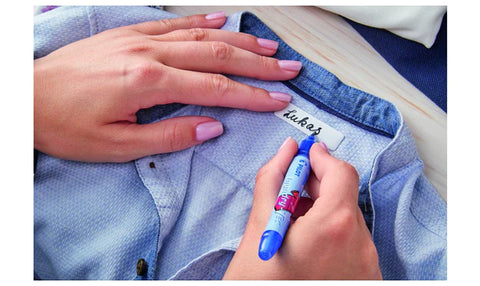
Uses: DIY clothing customization, textile art, labelling garments
Left-Handed Pens
For left-handed individuals, finding the right pen can make a significant difference in writing comfort and smudge-free writing.
Some fountain pens are available with left-handed nibs which turns right-handed pens into Left-handed pens.
The best left handed pens feature quick-drying ink and a design that accommodates the natural hand position of left-handed writers, reducing smudging and improving overall writing experience.
Example: Lamy Nexx Left-Handed Fountain Pen
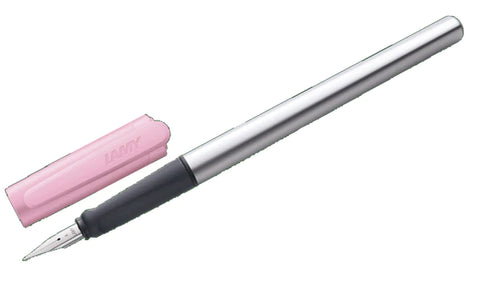
Uses: Note-taking, journaling, everyday writing tasks.
Find out how to choose the perfect pen for you based on your writing style and grip preference.
Conclusion
In conclusion, pens come in a wide variety of types, each with its own unique features, advantages, and uses.
Whether you prefer the timeless elegance of a fountain pen, the practicality of a ballpoint pen, or the versatility of a multifunction pen, there's a perfect writing companion out there for you.
So go ahead, explore, experiment, and find the pen that speaks to you and your writing style.
Happy writing!
Curious as to whether stationary can be eco friendly?
Also in Guides

Top 10 Must-Have Stationery Items for Aesthetic Organisation
Discover the top 10 must-have stationery items to elevate your organization game. From premium pens to stylish notebooks and highlighters, this guide features the best tools for an aesthetically pleasing and productive workspace.

LAMY Safari Note+ vs Apple Pencil
Two prominent contenders stand out for digital writing instruments for iPad users: the LAMY Safari Note+ and the Apple Pencil. This comparison delves into the advantages and disadvantages of the Apple Pencil and LAMY Safari Note+.


